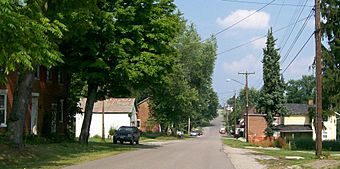Morristown Historic District facts for kids
Quick facts for kids |
|
|
Morristown Historic District
|
|

Main Street in the district
|
|
| Location | Church, Main, W. Cross, E. Cross, and Middle Cross Sts., Morristown, Ohio |
|---|---|
| Area | 42 acres (17 ha) |
| Architectural style | Greek Revival, Gothic Revival |
| NRHP reference No. | 80002943 |
| Added to NRHP | March 6, 1980 |
The Morristown Historic District is a special area in Morristown, Ohio, United States. It's recognized nationally for its history. This district includes a big part of the village. Morristown grew because it was built along the National Road. This was an important road long ago. The village did well as long as many people used the road. But it stopped growing when railroads became popular. Because Morristown didn't grow much or disappear, it still looks like it did in the mid-1800s. This makes it one of the National Road's best-preserved towns.
Contents
Discovering Morristown's History
Morristown was settled in the early 1800s. It really started to do well after 1826. That's when the National Road became its main street. For many years, the village depended a lot on this road.
The National Road's Impact
In the 1850s, Morristown was at its busiest. More than 40 businesses related to the National Road were open. They lined the streets, serving travelers and traders. But this good time didn't last. In the 1850s, railroads were built across eastern Ohio. These new trains took over as the main way to travel and move goods.
Since no railroad came through Morristown, it lost most of its businesses. People still built some new buildings until the 1870s. But after that, not much new construction happened.
Why Morristown Stayed the Same
Even though it didn't grow, the village remained. Because it wasn't torn down or heavily rebuilt, Morristown stayed preserved. This is sometimes called "benign neglect." It means that not much changed, which helped keep its old look. No other town along the National Road in eastern Ohio has changed so little since the road's busiest days.
Building Styles in Morristown
The way buildings were made is also important. Most buildings are "vernacular structures." This means they were built using local styles and materials. Many are made of brick using a special pattern called "Flemish bond." This brick style makes Morristown different from nearby towns. Most other historic towns around it have very few old brick buildings.
What Makes it a Historic District?
In early 1980, the Morristown Historic District was officially recognized. It covers about 42 acres. Out of 86 buildings in the district, 70 were called "contributing properties." This means they add to the historical importance of the area. The village cemetery is also a contributing property.
Because very few old buildings were torn down, Morristown still has most of its mid-1800s look. This is why the district is important. It shows us a lot about the area's history and its old architecture.



